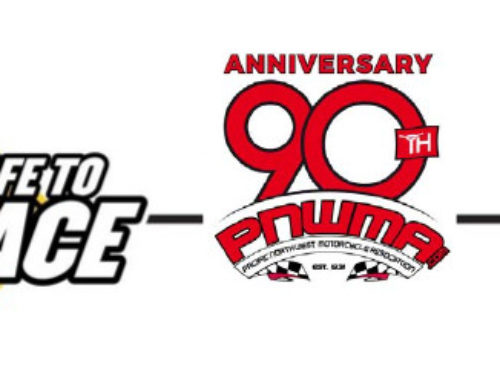The off-road racing community of BC is incredibly fortunate to have access to some of the most spectacular, varied and challenging terrain anywhere. The opportunity to compete on trails in coastal rain forests, rugged river valleys, interior plateaus and mountainous alpine areas is unique to our series. The PNWMA recognizes that the access we enjoy comes with a need to limit our impact, this requires planning on the part of the clubs hosting events. Areas of concern include wet lands, wildlife habitat, range lands, historically significant locations, streams and rivers. With proper planning clubs can balance environmental concerns with the desire to provide racers with a challenging off-road experience.
Guide Lines for Hosting an Event
Weather:
Host clubs should remain flexible with regards to the lay-out off their race course, recent rain fall or periods of extended dry weather may necessitate changes to the loop. During times of dry weather some terrain becomes very loose or silty developing deep ruts which may require repair for future use. Heavy rains or recent snow melt may create standing water and run-off destabilizing trails and increasing potential damage. Wind storms and downed trees prior to an event may result in excessive braiding or multiple lines forming adding to increased wear and tear. Clubs should always pre-ride the course immediately prior to the race to ensure the loop is passable, and make changes as required.
Trail Selection:
Consideration should be given to which trails are used during a race, more difficult terrain may require separate A and B sections to allow beginner classes a challenging yet passable loop. Trails that are very steep and prone to erosion should be used as down hills whenever possible. A race course that gains elevation by using roads and gradually climbing trail, experiences less erosion than a loop which climbs steep trail sections. The race course arrowing should be easy to follow and consistent to avoid racers getting lost and riding terrain not intended as part of the race. The host club should make every effort to balance the desire to provide a challenging loop with the need to conserve our trail resources.
Sanitation:
A plan should be put in place to allow for providing garbage disposal and porta-potties to ensure no waste is left behind. Garbage bags should be made available to racers to allow them to pitch in with maintaining a clean staging area.
Communications:
The riders meeting and awards ceremony are both good venues to mention the need to keep the staging area clean. Signage around the race staging area asking participants to use the provided garbage bags/cans and avoid sensitive terrain pays big dividends with keeping riding areas open for motorcycle use. Also by mentioning the benefits of limiting our impact to the trails when racing and play riding we can help to spread the word about conservation. Included below is the TORCA wet weather riding guide and links to other trail conservation resources.
Riding in the Wet – A message from TORCA Trail Director
February 28, 2015
We are fortunate living where we do; mild winters and a lot of different riding destinations to choose from, which means riding is a round the year possibility. This benefit does come with a couple of drawbacks, firstly, and most prominently, it rains here… A lot! Recently, we’ve seen record rainfalls, and the heavy rain events have been frequent enough that adequate drainage has not occurred, leaving the ground totally saturated, the lack of snow also means that trails don’t get a rest period, so they are seeing heavier than normal traffic for this time of year because people aren’t able to ski, two events that can be problematic.
With modern trail building practices that follow the IMBA and Whistler trail standards, the trails are able to withstand bad weather and heavy traffic better than ever, but building to these standards is incredibly labour intensive, not always the most ideal solution for a particular area, in turn, this means that the trail will not necessarily be able to handle high traffic or wet weather, so it’s good to know how to identify trails that will handle the rain, and also to understand what trails are best left for drier days. It’s really difficult to tell someone not to do something, and the aim of this article is to educate so that you can make an informed decision on when and what to ride.
Before You Ride:
Think about what trails you are going to ride:
-Soil Type: Are they typically muddy?
-Trail Grade: How steep are they?
-Special Restrictions: Are there any special restrictions put on by the builder or trail group?
-Plan Your Ride: Do you have a backup plan in case conditions are worse than anticipated?
Soil Type:
The type of soil on the trail bed contributes to how well the trail will drain. In it’s natural state, the forest floor is made up of sticks, pine needles, leaves and other organic debris that is in various stages of decomposition. This material is known as duff, and if you pick it up, it’s loose, doesn’t pack, can hold a lot of water like a sponge, and when worked will break down into a black, sloppy muck that takes a long time to dry out. It’s the trail surface that is typical for ‘loamers’, the primitive trails that when dry are the dirt equivalent to skiing on a powder day, but in the wet, they are greasy, fragile and waterlogged. If you finish a ride and are covered in mud, then that mud has come from the trail, and it’s not going to be replaced without intervention, it’s a good marker for erosion!
The gold soil that has become ubiquitous with modern trail building is the local mineral soil. It’s a mixture of fine gravel, sand, silt and a small amount of clay with minimal organic matter. It is technically called loam (which is often confused with duff as mentioned above). When it’s worked, it will compact down, and the clay and silt will bond everything together forming a hardened layer that can shed water and is very resistant to wear from foot and wheel traffic. Building trail with this is labour intensive, generally consisting of removing the duff, back filling with rock, and crowning with soil to form the trail surface.
Rock is fantastic, it doesn’t really wear (although it can get polished), it doesn’t change, it can handle any amount of weather, but it can also channel water onto the rock-trail boundary, and the end of rock sections will often be rutted because of braking and water erosion.
After a heavy rainfall, it takes time for the trails to dry out to a rideable level. With armoured mineral soil trails, they can sometimes be good through the rain event or up to two or three days after. Organic surfaced trails can take weeks to dry out properly depending on the slope of the hill, sunlight and other factors.
Trail Grade:
Water on a trail is generally bad, but it becomes an erosive force when it’s moving, and as it’s speed picks up, so does it’s potential for damage. A well built, well maintained trail will have out-slopes on the trail bed to sheet water off to the side without it picking up much momentum, as a backup, there will also be grade reversals, small speed bumps or changes in grade from downhill to uphill that force the water off the trail before it can turn into a creek.
Standing water is generally not an issue unless the ground is totally saturated, at which point it will soften and riding through will create channels that could either promote water flow/channeling, or more common, people will choose to ride around the puddle because they don’t want to get wet, which turns that lovely narrow single track into a wide swamp.
If a trail is very steep, the water will pick up momentum quickly, meaning that it’s more likely to channel and erode if the water isn’t managed properly. Not a problem if the trail is down to hardpan, but also, not the most desirable trail surface to ride on. Channeled water is also unpredictable, so the trail surface, when eroded, could be hazardous.
Special Restrictions:
Sometimes, because of conditions, fresh work that needs to bed in and set, or a variety of other reasons, a trail may be temporarily closed. Check with the local builder or organization to find out if there is any current issue before starting your ride. If you come across something like this mid-ride, please respect the closure, even if it does mean you don’t get the ride you like. Letting trails rest now means that they will be better in the future!
Plan Your Ride:
Before you start your ride, know where you are going, plan some contingencies in case conditions turn bad and your destination is now not suitable for the conditions. If it is wet, tread lightly, don’t ride full speed and skid everywhere, as conditions will be a bit more fragile as well as unpredictable.
Have Fun!
Every day of riding this time of year is a bonus day, since we haven’t really had a traditional winter. If you treat every ride like this following the guide above, then you will be.
-Steve Sheldon, TORCA Director of Trails



